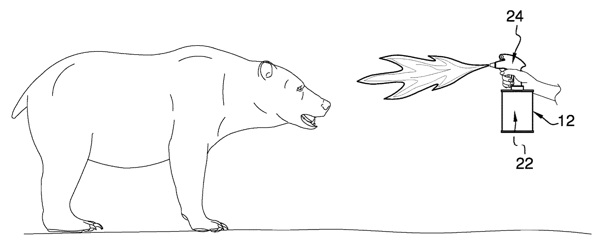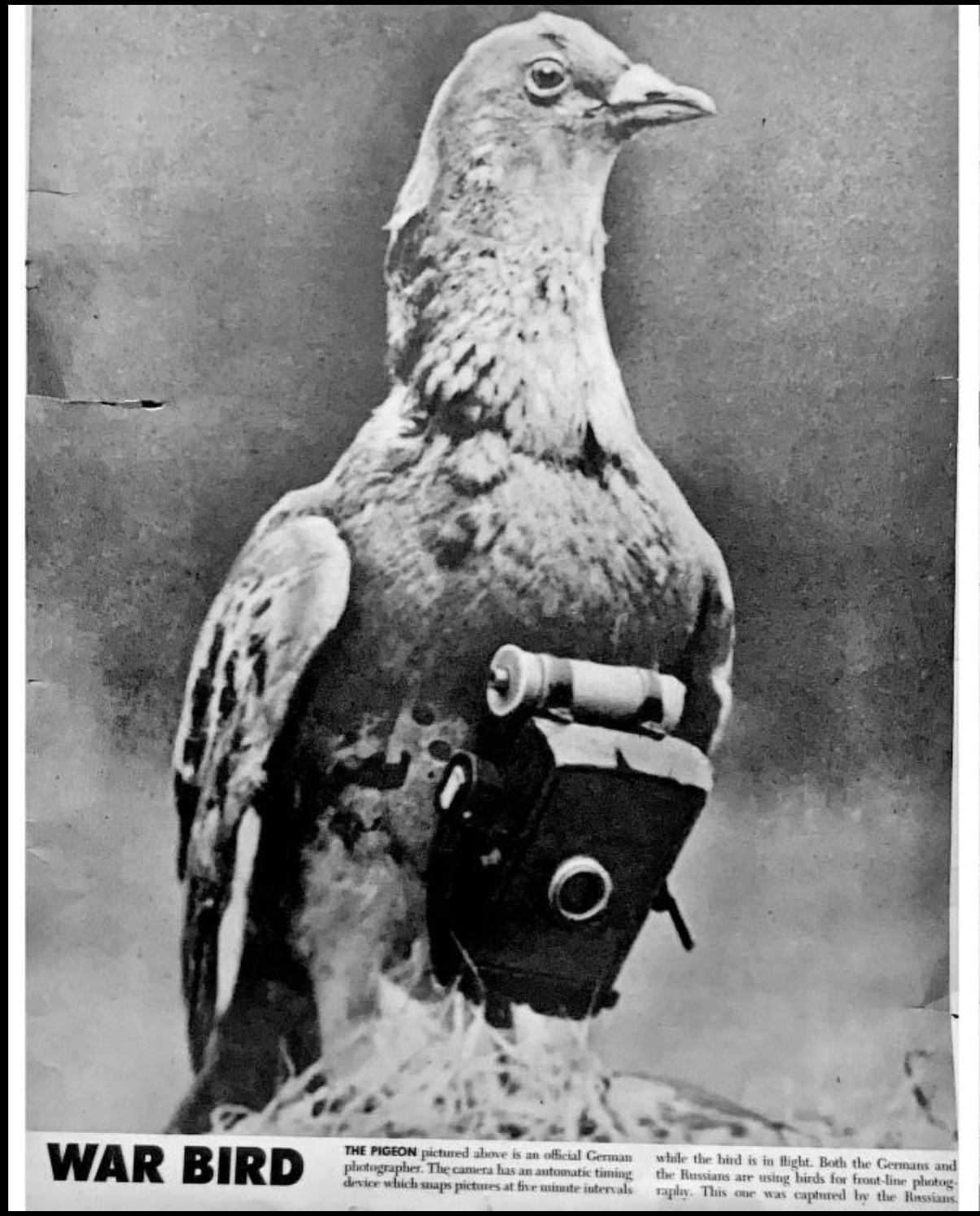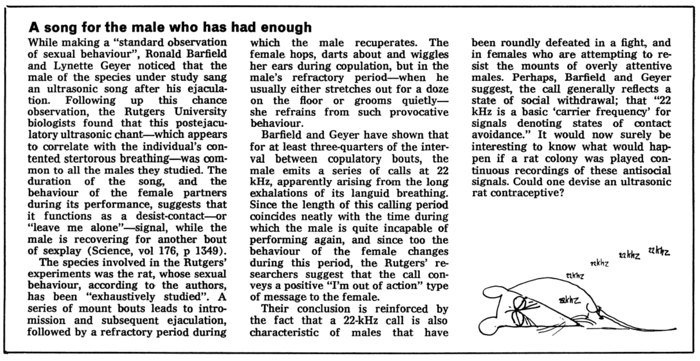Animals
Anti-Bear Flamethrower
David Girag of Glendale, CA recently was granted a patent (11,877,572) for a "portable flame propelling device" to deter an attack by an animal "such as a bear, lion, dog, or human."I think this would just anger a bear, and then cause a forest fire.

Posted By: Alex - Tue Jan 30, 2024 -
Comments (3)
Category: Animals, Fireworks and Pyrotechnics, Patents, Weapons
The Highwaymen, “The Bird Man”
For our category of Actors Who Unwisely Attempt "Singing"
Posted By: Paul - Tue Jan 30, 2024 -
Comments (1)
Category: Animals, Crime, Movies, Music, 1960s
Anting
A strange behavior engaged in by birds. From wikipedia:
Posted By: Alex - Sat Jan 27, 2024 -
Comments (6)
Category: Animals, Insects and Spiders
Pigeon Drones
Read all about the wartime practice of mounting cameras on pigeons.At Wikipedia.
And at Public Domain Review, where there are more pictures.


Posted By: Paul - Wed Jan 17, 2024 -
Comments (0)
Category: Animals, Inventions, Photography and Photographers, War, Twentieth Century
Follies of the Madmen #579

Posted By: Paul - Wed Oct 25, 2023 -
Comments (0)
Category: Animals, Anthropomorphism, Bad Habits, Neuroses and Psychoses, Advertising, Coffee and other Legal Stimulants, 1980s
Female mate avoidance behaviors in the European common frog
We posted recently about "misdirected amplexus," which is the phenomenon of male frogs attempting to mate with inappropriate objects (different species, fish, inanimate objects, etc.).Turns out that the weird frog sex behaviors don't end there. Male frogs, in their excitement, will occasionally form "mating balls" — "several male frogs cling to a single female – often killing her in the process."
Some German researchers have now found that female frogs, in turn, have developed defense strategies to protect themselves from over-excited males. They rotate to try to escape the male's grasp; they emit "release calls"; and if those strategies fail to work, they play dead:
More info: "Drop dead! Female mate avoidance in an explosively breeding frog" – technologynetworks.com
(Thanks to Gerald Sacks)
Posted By: Alex - Fri Oct 13, 2023 -
Comments (4)
Category: Animals, Nature, Science, Sex
Ultrasonic Postejaculatory Song of the Male Rat
We posted recently about some odd sexual behavior demonstrated by frogs (their frequent attempts to mate with inappropriate objects). Male rats also display an odd behavior. When they need to rest from mating, they sing an ultrasonic "leave me alone" song.More info: PubMed

Posted By: Alex - Sat Oct 07, 2023 -
Comments (0)
Category: Animals, Nature, Science, Sex
The Chimpomat
In one of our recent posts, there was a reference to the Chimpomat, a token-operated vending machine for chimpanzees created at the Yerkes Laboratories in the 1930s. Here's more info about it.
"Subject Kambi is shown about to drop a token into the slot of the chimpomat to 'purchase' food."
Info from The Ape People (1971) by Geoffrey H. Bourne:
By the process of lengthening the time between which they could earn the reward and when they could actually receive it by using the Chimpomat (by making the Chimpomat available only certain times of the day), the animals could be trained to collect plastic disks, in other words, to work for money. They would store up this money until the time came for them to spend it. Eventually they were trained to earn the money one day and spend it in the Chimpomat the following day.
On these occasions the animals used to walk around clutching their earnings to their breasts, sleeping on them at night so they would not be stolen, and getting very hysterical if any other animal came near their earnings or tried to take any of them away—a very human side of their actuvity and the dawn of ownership of private property and capitalism, a thought that has intriguing implications.
Posted By: Alex - Mon Oct 02, 2023 -
Comments (1)
Category: Animals, Science, 1930s
Misdirected amplexus
"Misdirected amplexus" is the scientific term for the curious phenomenon of male frogs attempting to mate with inappropriate objects. Details from the New ScientistFrog mating is often hard to miss. In most species it involves a process called amplexus, in which males grip onto a female tightly for hours or days at a time until the eggs are fertilised. But there are plenty of records of male frogs grappling an unpromising target such as a frog from a different species or a dead individual. One explanation is that such mistakes are more likely to happen in species that breed in large numbers with a low ratio of females to males, and where multiple species occupy the same breeding pond.
I briefly discussed the subject of misdirected mating in the animal kingdom in my book Elephants on Acid. Here's the relevant text:
During the early 1950s, researchers at Walter Reed Army Medical Center surgically damaged the amygdala (a region of the brain) in a number of male cats. These cats became "hypersexual," attempting to mate with a dog, a female rhesus monkey, and an old hen. Four of these hypersexual cats, placed together, promptly mounted one another.
Posted By: Alex - Tue Sep 26, 2023 -
Comments (0)
Category: Animals, Nature, Science, Sex
Rare Bird Beauty Contest
Posted By: Paul - Fri Sep 15, 2023 -
Comments (0)
Category: Animals, Awards, Prizes, Competitions and Contests, Beauty, Ugliness and Other Aesthetic Issues, 1940s

| Who We Are |
|---|
| Alex Boese Alex is the creator and curator of the Museum of Hoaxes. He's also the author of various weird, non-fiction, science-themed books such as Elephants on Acid and Psychedelic Apes. Paul Di Filippo Paul has been paid to put weird ideas into fictional form for over thirty years, in his career as a noted science fiction writer. He has recently begun blogging on many curious topics with three fellow writers at The Inferior 4+1. Contact Us |




